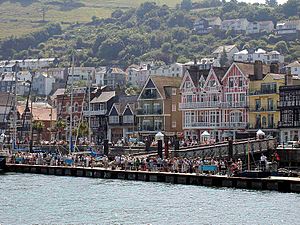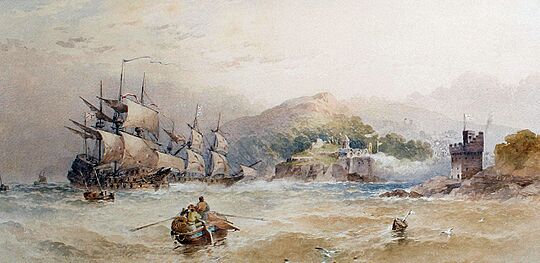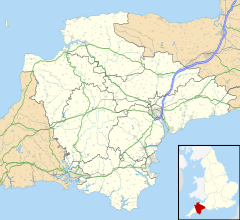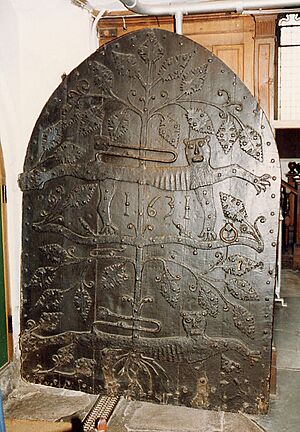Dartmouth, Devon facts for kids
Quick facts for kids Dartmouth |
|
|---|---|
 Dartmouth from the River Dart |
|
| Population | 5,064 (2011) |
| OS grid reference | SX877514 |
| Civil parish |
|
| District | |
| Shire county | |
| Region | |
| Country | England |
| Sovereign state | United Kingdom |
| Post town | DARTMOUTH |
| Postcode district | TQ6 |
| Dialling code | 01803 |
| Police | Devon and Cornwall |
| Fire | Devon and Somerset |
| Ambulance | South Western |
| EU Parliament | South West England |
| UK Parliament |
|
Dartmouth is a historic town and civil parish in the English county of Devon. It's a popular place for visitors, located on the western side of the River Dart. The river here is a long, narrow tidal inlet that stretches inland to Totnes. Dartmouth is part of the beautiful South Devon Area of Outstanding Natural Beauty. In 2011, about 5,064 people lived there.
Contents
- Dartmouth's Story: A Look Back in Time
- Early Days and Port Life
- Royal Connections and Defenses
- Famous Visitors and Privateers
- Old Streets and Churches
- Becoming a Royal Borough
- Land Changes and New Areas
- The Spanish Armada and Treasure Ships
- Pilgrim Fathers and Historic Buildings
- English Civil War Defenses
- Changes in the 1800s
- The 1900s and World War II
- Recent Times
- How Dartmouth is Governed
- Fun Things to Do and See
- Weather in Dartmouth
- Getting Around Dartmouth
- Media and News
- Learning in Dartmouth
- Sports and Fun
- Famous People from Dartmouth
- Images for kids
- See also
Dartmouth's Story: A Look Back in Time
Early Days and Port Life
Back in 1086, a very old book called the Domesday Book mentioned a settlement called Dunestal where Dartmouth is now. It was a farming village. Over time, Dartmouth grew into an important port. Its deep waters were perfect for sailing ships.
Dartmouth was a key starting point for the Crusades in 1147 and 1190. Some say Warfleet Creek, near Dartmouth Castle, got its name from the huge fleets of ships that gathered there.
Royal Connections and Defenses
The Royal Navy has used Dartmouth since the time of King Edward III. During the Hundred Years' War, the town was attacked twice. After these attacks, a large chain was used to close the mouth of the river every night for protection. Today, the narrow entrance to the River Dart is still guarded by two old castles: Dartmouth Castle and Kingswear Castle. The town's first wharf (a place for ships to dock) was Bayard's Cove, a small area protected by a fort.
Famous Visitors and Privateers
In 1373, the famous writer Geoffrey Chaucer visited Dartmouth. He even mentioned a "schipman" (sailor) from Dartmouth in his famous book, The Canterbury Tales.
Dartmouth was also a major base for privateers in medieval times. These were private ships allowed by the government to attack enemy ships. John Hawley, a privateer and mayor of Dartmouth, is thought to be the inspiration for Chaucer's sailor.
Old Streets and Churches
The oldest street in Dartmouth is Smith Street, first mentioned in the 1200s. Many houses there were built in the late 1500s or early 1600s. This street was important for smiths and shipbuilders who worked on ships when the river reached this far.
The first church in the area was St Clement's, Townstal, built around the 1190s. Later, St Saviour's Church was built in 1335. It has a beautiful old wooden screen from 1480 and a large medieval iron door. This door is decorated with two leopards, symbols of the Plantagenet royal family.
Becoming a Royal Borough
In 1281, it was decided that the Lord of Totnes could charge tolls on ships using the river. Later, in 1327, the town, river, and port were given to the king, making Dartmouth a Royal Borough. In 1341, Dartmouth received a Royal Charter, which allowed the town to elect its own mayor. This made the town more independent.
Land Changes and New Areas
In 1671, a new area called the "New Ground" was created by building up a sandbank with ship's ballast. This made more space for ships to dock. Today, this area is the Royal Avenue Gardens.
The Spanish Armada and Treasure Ships
Dartmouth sent many ships to join the English fleet against the Spanish Armada in 1588. One Spanish ship, the Nuestra Señora del Rosario, was captured and brought to the River Dart.
In 1592, a huge Portuguese treasure ship called the Madre de Deus docked in Dartmouth. It was full of riches and attracted many people. Even after some treasure went missing, ten large ships were needed to carry the rest to London!

Pilgrim Fathers and Historic Buildings
Henry Hudson, a famous explorer, stopped in Dartmouth on his way back from North America. The Pilgrim Fathers also stopped at Bayard's Cove in Dartmouth in 1620. They rested before continuing their journey to America on the Mayflower and the Speedwell. When the Speedwell proved unseaworthy, the Mayflower continued alone. Dartmouth's sister city in America is Dartmouth, Massachusetts.
The town has many old streets and buildings from medieval and Elizabethan times. One famous building is the Butterwalk, built between 1635 and 1640. It has beautiful carved wooden supports. King Charles II even held court here in 1671.
The Royal Castle Hotel, built in 1639, is another historic building. The Cherub pub, built around 1380, is thought to be one of the oldest buildings in town.
English Civil War Defenses
During the English Civil War, a fort called Gallants Bower was built by the Royalists around 1643 to defend the town. In 1646, the Parliamentarian army attacked and captured Dartmouth, and the fort was later destroyed.
Changes in the 1800s
Before 1671, much of the town centre was muddy tidal flats. In the 1800s, new roads were built, and parts of the town were widened. In 1881, a plan for an embankment or esplanade was made to attract tourists and provide more space for boats. This was finished in 1885.
When steamships became popular, Dartmouth became a place where ships could get coal. This led to very crowded living conditions for the coal workers near the river.
The 1900s and World War II
In the 1920s, the town council began to clear the crowded living areas. New houses were built in the Britannia Avenue area.
During the later part of World War II, Dartmouth was a base for American forces. It was one of the departure points for Utah Beach during the D-Day landings. The nearby Slapton Sands area was used by US troops for practice landings.
Recent Times
Between 1985 and 1990, the Embankment was made wider and higher to prevent flooding. A special gate was added at the Boatfloat bridge to close during high tides.
In 2010, a fire badly damaged several historic buildings in Fairfax Place and Higher Street.
How Dartmouth is Governed
Dartmouth used to be an ancient borough, which is a type of town with special rights. It was known as Clifton-Dartmouth-Hardness. The town had its own Member of Parliament until 1868.
Today, Dartmouth has a town council made up of 16 councillors. This is the lowest level of local government. Dartmouth is also part of the South Hams District Council and the Devon County Council.
Fun Things to Do and See
Events and Festivals
The Port of Dartmouth Royal Regatta is a big event that happens every year for three days at the end of August. It includes boat races, markets, fun fairs, music, air shows (sometimes with the Red Arrows!), and fireworks. A Royal Navy ship often visits during the event.
Other fun events include beer festivals, a music festival, an art and craft weekend, a food festival, and a Christmas candlelit event.
The Flavel Centre is a community building that has a public library and spaces for films, live music, comedy, and art shows.
Filming Locations
Bayard's Cove has been used as a filming location for several TV shows, including The Onedin Line and Down to Earth.
Popular Attractions
- The Dartmouth Royal Naval College: This is where officers for the Royal Navy are trained.
- Bayard's Cove Fort: An old fort that protected the town.
- Dartmouth Castle: One of the two castles guarding the river entrance.
- The Dartmouth Steam Railway: A fun steam train ride that ends in Kingswear, across the river.
You can also take boat trips along the coast or up the river to places like Totnes and the Greenway Estate (which was once home to famous author Dame Agatha Christie). The South West Coast Path also passes through Dartmouth, offering great walks.
The area is very popular for yachting, with many marinas for boats.
Weather in Dartmouth
Dartmouth has a maritime climate, which means it has warm summers and mild winters. This is because it's close to the coast. The temperature usually stays between 3.8°C (39°F) in winter and 20.7°C (69°F) in summer. The wettest months are usually November and December.
| Climate data for Slapton, elevation: 32 m (105 ft), 1981–2010 normals, extremes 1960–present | |||||||||||||
|---|---|---|---|---|---|---|---|---|---|---|---|---|---|
| Month | Jan | Feb | Mar | Apr | May | Jun | Jul | Aug | Sep | Oct | Nov | Dec | Year |
| Record high °C (°F) | 14.6 (58.3) |
16.2 (61.2) |
19.5 (67.1) |
20.5 (68.9) |
24.0 (75.2) |
30.5 (86.9) |
28.0 (82.4) |
28.5 (83.3) |
25.0 (77.0) |
21.9 (71.4) |
17.7 (63.9) |
15.7 (60.3) |
30.5 (86.9) |
| Mean daily maximum °C (°F) | 9.2 (48.6) |
9.1 (48.4) |
10.8 (51.4) |
12.8 (55.0) |
15.7 (60.3) |
18.6 (65.5) |
20.7 (69.3) |
20.7 (69.3) |
18.5 (65.3) |
15.2 (59.4) |
12.0 (53.6) |
9.8 (49.6) |
14.5 (58.1) |
| Daily mean °C (°F) | 6.5 (43.7) |
6.3 (43.3) |
7.8 (46.0) |
9.2 (48.6) |
12.1 (53.8) |
14.6 (58.3) |
16.8 (62.2) |
16.9 (62.4) |
15.0 (59.0) |
12.3 (54.1) |
9.2 (48.6) |
7.1 (44.8) |
11.1 (52.0) |
| Mean daily minimum °C (°F) | 3.8 (38.8) |
3.5 (38.3) |
4.8 (40.6) |
5.6 (42.1) |
8.4 (47.1) |
10.6 (51.1) |
12.8 (55.0) |
13.0 (55.4) |
11.4 (52.5) |
9.3 (48.7) |
6.4 (43.5) |
4.4 (39.9) |
7.9 (46.2) |
| Record low °C (°F) | −8.0 (17.6) |
−6.8 (19.8) |
−6.5 (20.3) |
−2.5 (27.5) |
−0.1 (31.8) |
2.5 (36.5) |
6.2 (43.2) |
6.0 (42.8) |
3.9 (39.0) |
0.2 (32.4) |
−2.7 (27.1) |
−6.0 (21.2) |
−8.0 (17.6) |
| Average precipitation mm (inches) | 123.5 (4.86) |
94.0 (3.70) |
90.0 (3.54) |
70.4 (2.77) |
67.0 (2.64) |
60.9 (2.40) |
63.8 (2.51) |
66.1 (2.60) |
71.9 (2.83) |
114.3 (4.50) |
118.6 (4.67) |
133.5 (5.26) |
1,074 (42.28) |
| Average precipitation days (≥ 1.0 mm) | 14.7 | 11.5 | 12.7 | 10.5 | 9.9 | 8.2 | 8.6 | 9.2 | 9.7 | 13.7 | 14.5 | 14.6 | 137.7 |
| Mean monthly sunshine hours | 57.5 | 76.4 | 118.5 | 180.7 | 210.7 | 213.9 | 215.6 | 198.0 | 154.9 | 102.3 | 74.8 | 48.3 | 1,651.6 |
| Source 1: Met Office | |||||||||||||
| Source 2: KNMI | |||||||||||||
Getting Around Dartmouth
Ferries and Roads
Dartmouth is connected to Kingswear (on the other side of the River Dart) by three ferries. Two of them carry cars, and one is just for passengers. The passenger ferry is mainly used to connect with the Dartmouth Steam Railway at Kingswear railway station. The nearest bridge across the Dart is in Totnes, about 11 miles away by road.
The A379 road goes through Dartmouth, connecting it to other towns. The A3122 road also links Dartmouth to the A381 road, which leads to Totnes and Kingsbridge.
Buses and Trains
Stagecoach South West provides local bus services in Dartmouth and connects the town to places like Plymouth, Totnes, and Exeter.
No railway line has ever reached Dartmouth directly. However, the town does have a railway station building, which opened in 1890. It's now a restaurant. The railway line to Kingswear opened in 1864. Passengers would take a ferry across the river to Dartmouth. The line closed to regular trains in 1973 but reopened as a heritage line, which means it's now a fun tourist attraction with old trains.
Media and News
You can watch local TV news from BBC West and ITV West Country.
Local radio stations include BBC Radio Devon, Heart West, Greatest Hits Radio South Devon, and Radio Exe.
The Dartmouth Chronicle is the town's local weekly newspaper.
Learning in Dartmouth
Dartmouth is home to the Royal Navy's officer training college, called the Britannia Royal Naval College. This is where all officers for the Royal Navy, and many from other countries, receive their training.
Schools
Dartmouth has one primary school, St John the Baptist R.C. Primary School. It also has an all-through school called Dartmouth Academy for students aged 3 to 16. There's also a pre-school in the town centre for younger children.
Sports and Fun
Dartmouth has a Non-League football club called Dartmouth A.F.C. They play at a ground called Long Cross.
The town also hosts the annual "World Indoor Rally Championship," which is a fun event based on slot car racing.
At the end of August and beginning of September, the annual Port of Dartmouth Royal Regatta takes place, which is a big sporting and community event.
Famous People from Dartmouth
- George Parker Bidder (1806–1878): A brilliant civil engineer and amazing mental calculator.
- Simon Drew (born 1952): A well-known cartoonist and illustrator who lives in Dartmouth.
- John Flavel (c.1627–1691): An English minister and author.
- Rachel Kempson (1910–2003): A famous actress who was born in Dartmouth. She was the wife of Sir Michael Redgrave and mother to actresses Vanessa and Lynn.
- Christopher Robin Milne (1920–1996): The son of author A. A. Milne, who inspired the character Christopher Robin in the Winnie-the-Pooh books. He used to own a bookshop in Dartmouth.
- Thomas Newcomen (1664–1729): The inventor of the atmospheric engine, the first successful steam-powered engine. He was born in Dartmouth.
- Mary Nightingale (born 1963): An ITV news presenter who grew up in Dartmouth.
- Flora Thompson (1876–1947): An author who lived in Dartmouth and wrote parts of her famous book Lark Rise to Candleford there.
Images for kids
See also
 In Spanish: Dartmouth (Inglaterra) para niños
In Spanish: Dartmouth (Inglaterra) para niños








